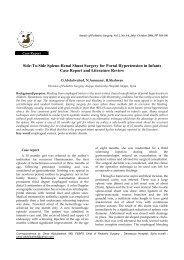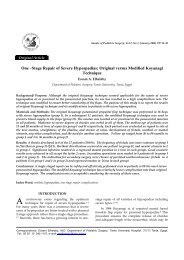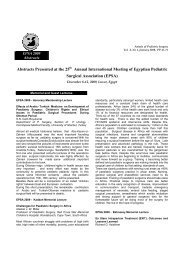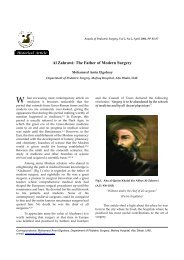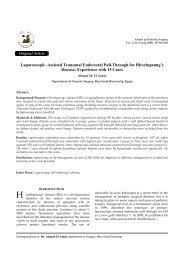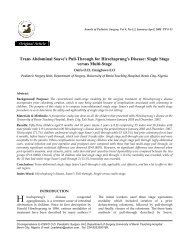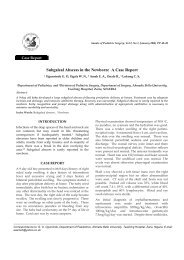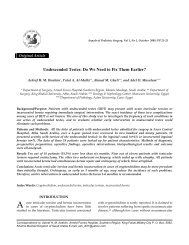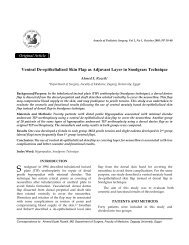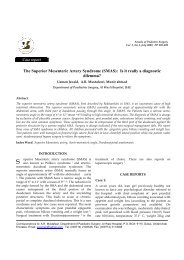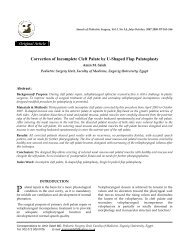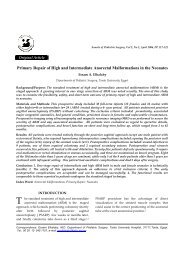Closure of Palatal Fistula with Bucco-labial Myomucosal Pedicled Flap
Closure of Palatal Fistula with Bucco-labial Myomucosal Pedicled Flap
Closure of Palatal Fistula with Bucco-labial Myomucosal Pedicled Flap
Create successful ePaper yourself
Turn your PDF publications into a flip-book with our unique Google optimized e-Paper software.
El-Leathy M, Attia M<br />
Fig7. A photograph showing the healed buccal flap<br />
<strong>with</strong> a guide wire under its pedicle as there is no<br />
fibrosis or adhesions below.<br />
Fig 8. A photograph showing the buccal flap after cutting its<br />
pedicle (weaning)<br />
Fig 9. A photograph showing a completely healed pedicle <strong>with</strong> good vascularity sealing the alveolar margin<br />
defect which needs no weaning.<br />
DISCUSSION<br />
Methods currently employed for fistula repair can be<br />
broadly divided in two groups: those that use<br />
mucoperiosteal flaps in one way or another, e.g.,<br />
hinge flaps 10 , and those that make use <strong>of</strong> additional<br />
tissue to close the defect. Sources <strong>of</strong> additional tissue<br />
are usually in the form <strong>of</strong> pedicled flaps from<br />
elsewhere in the mouth, according to the site <strong>of</strong> fistula<br />
e.g., buccal mucosa 8 or tongue flaps. 7 The simplest<br />
way to close a fistula is by raising a mucoperiosteal<br />
flap, as in primary cleft palate repair; but it is not the<br />
most successful one due to variable local causes e.g.<br />
scarring, inadequate palatal tissue and/or local<br />
ischemia.<br />
Reasonable results have been obtained in this study<br />
using virgin highly vascular new tissue from the<br />
neighboring buccal surface <strong>of</strong> the upper lip up to the<br />
gingivo-<strong>labial</strong> fold or buccal surface <strong>of</strong> the cheek. The<br />
used flap has a double blood supply, first supply is<br />
from the pedicle and the second supply is from the<br />
raw de-epithelialised surface done by dermabrasion<br />
all around the fistula opening.<br />
Intuitively, one-layer closures using mucoperiosteal<br />
flap i.e. hinge flap will leave a raw surface on the<br />
buccal side that is usually prone to bleeding and/or<br />
improper healing <strong>with</strong> high incidence <strong>of</strong> fistula<br />
recurrence. In this study there is no need to do that, so<br />
the net result repair <strong>of</strong> fistula is devoid <strong>of</strong> local tissue<br />
trauma or tension at sutures line.<br />
Postpalatoplasty oro-nasal fistulas in cleft palate<br />
patients are notoriously difficult to reconstruct, <strong>with</strong><br />
an accepted treatment failure rate <strong>of</strong> at least 10%. 6 The<br />
107 Vol 5, No 2, April 2009



